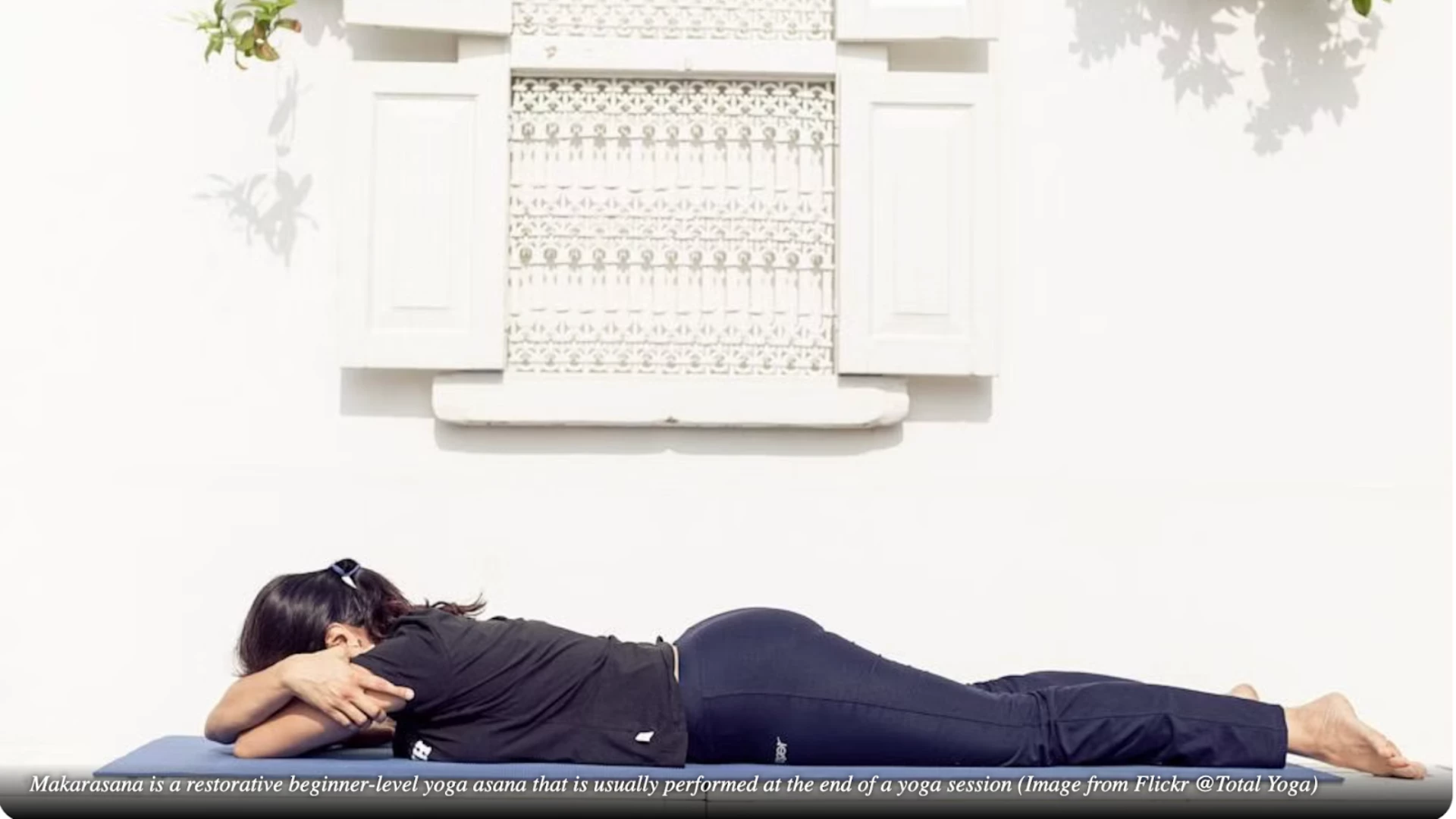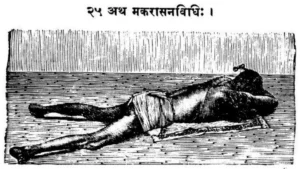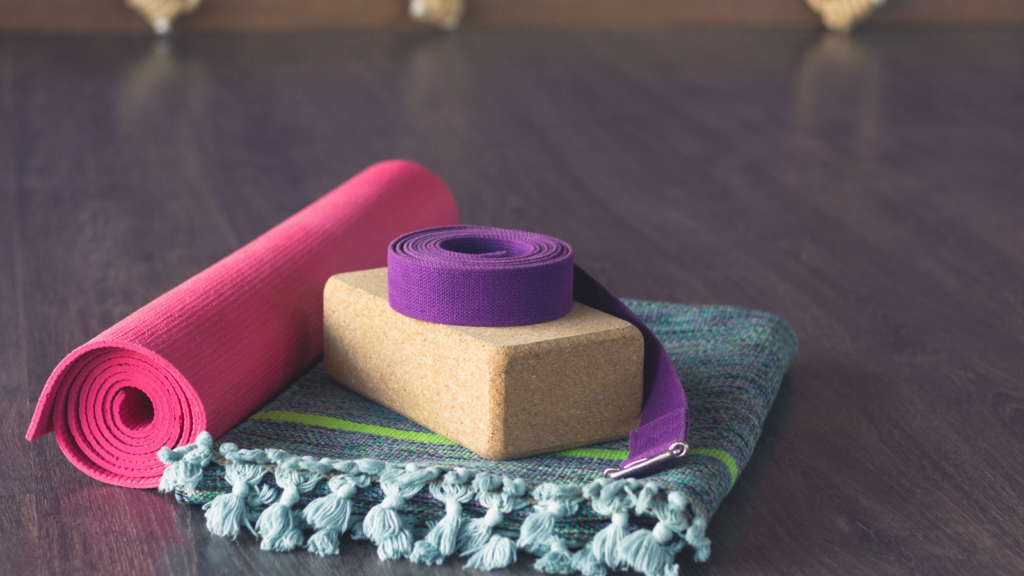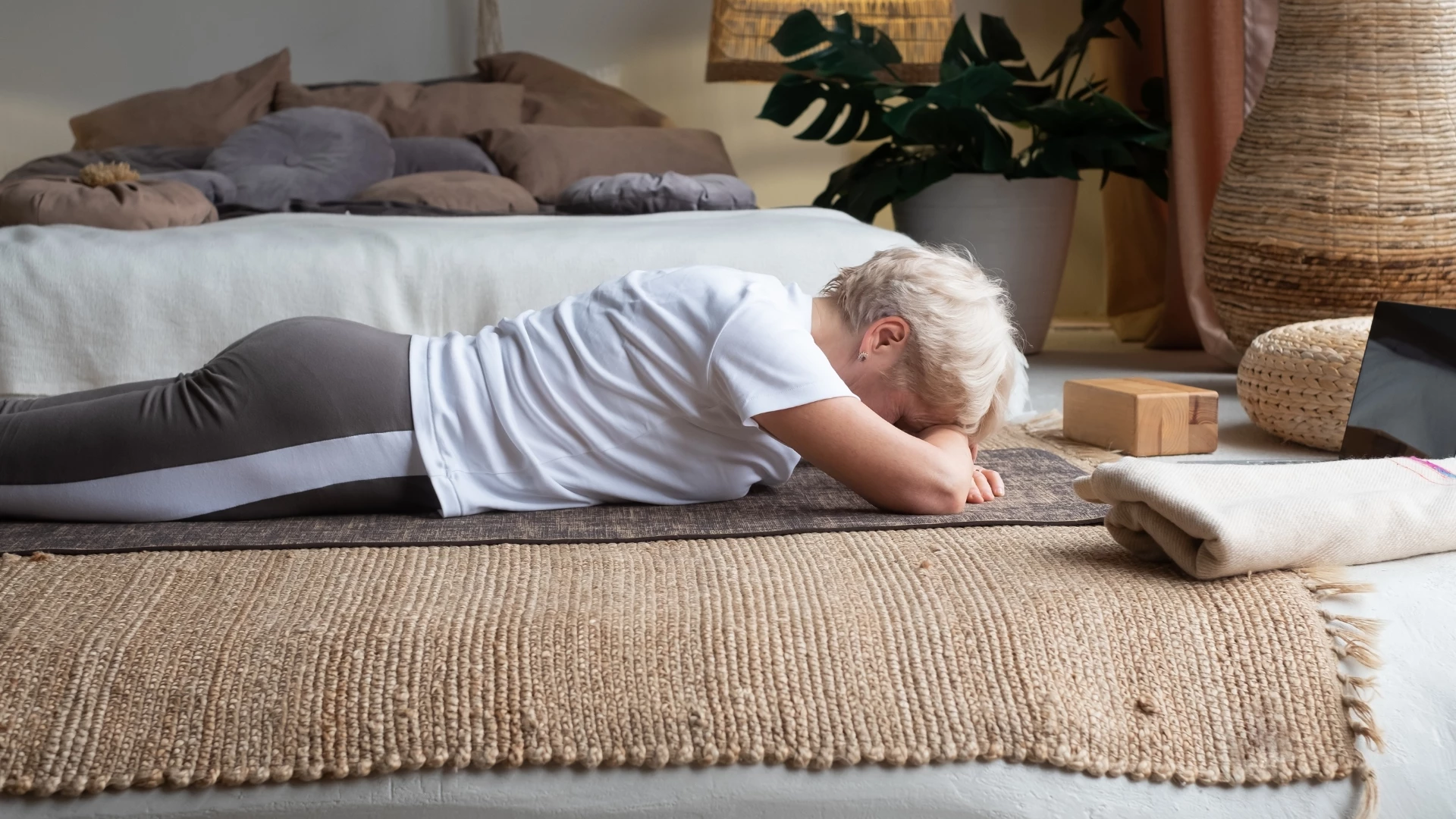Hatha Yoga: How to Practice Crocodile Pose (Makarasana)

Article At A Glance
Makarasana, in its simplest variation, is a soothing and effective relaxation pose that can be practiced by both beginners as well as experienced practitioners looking for a restorative yoga pose.
Crocodile Pose (Makarasana) is a versatile yoga pose with many variations to fit the different objectives you set for your yoga practice.
In its simplest variation, it is a soothing and effective relaxation pose that can be practiced by both beginners as well as experienced practitioners looking for a restorative yoga pose.
One of the key benefits of practicing Crocodile Pose is that it can help facilitate diaphragmatic breathing, one of the important first steps in yogic breathing practices.
By virtue of deepening the breath, Makarasana will also help tone the vagus nerve and calm the nervous system to induce the relaxation response (see below). For this reason, practicing Crocodile Pose regularly is said to help manage emotions, reduce stress, and improve overall health.
What’s in the Name: Makarasana?

The origin of the name Makarasana can be traced back to Sanskrit, where makara means crocodile or monster, and āsana means posture or seat.
Makara is commonly translated as crocodile, but it may have been a mythical creature or even a sea creature like a shark or dolphin. In Hindu mythology, it was the animal vehicle of the sea-god Varuna and the river-goddess Ganga.
The pose is one of 37 asanas illustrated in the Yogasopana Purvacatuska from 1905. The Yogasopana Purvacatuska (translated as “Stairway to Yoga”) was the first modern, illustrated book on hatha yoga. This marked a shift from a secretive approach to a more open dissemination of hatha yoga’s practices.
How to Practice Crocodile Pose (Makarasana I) in Hatha Yoga
- Begin by lying face down on a yoga mat. Keep your legs loose and relaxed with your knees shoulder-width apart.
- Crocodile Pose is most often instructed with your toes turned out and heels turned in, which offers a nice stretch of the ankles in a direction we rarely move them. However, the key is to have your legs feel loose and relaxed, so if pointing your toes outward is not comfortable, simply point your feet inward.
- Fold your arms and place your hands on the opposite elbows, drawing them toward you so that your shoulders and upper chest are slightly off the floor. Alternatively, you can cross your arms, bringing your hands to the opposite shoulders, and cradle your head in the crook of your elbows. Rest your forehead on your forearms or the floor, depending on which variation you choose.
- In Makarasana I, your abdomen should rest fully on the floor, your upper chest should be slightly elevated, and the weight of your upper torso should rest on your abdomen and lower ribcage.
- Close your eyes and relax your face, shoulders, abdomen, pelvis, legs, and feet. Breathe deeply and slowly, focusing on the sensation of the pressure of the floor against your belly as it expands and contracts with each inhalation and exhalation.
Tips for Practicing Crocodile Pose

- Crocodile Pose is best practiced for 5 to 10 minutes, but you can start with a shorter duration and gradually increase it as you become more comfortable. If you experience discomfort in your neck or upper spine, try extending your arms further from your torso. You can also use a thin cushion or folded blanket to rest your upper chest on, which will make the pose more comfortable for your neck and shoulders.
- Remember to modify the pose as necessary to make it comfortable for you, and focus on breathing deeply and slowly to get the most benefits from the pose.
- In addition to changing the position of the feet and legs, you can experiment with moving the arms closer to your body, so more of your upper torso is off the ground and there is more pressure on the abdomen.
- To increase the backbending action in the pose, try moving your arms closer to your body, so your upper body is lifted higher. You can also put your arms on a block.
Benefits of Crocodile Pose: A Basic Restorative Yoga Pose
- This pose promotes deep relaxation by releasing tension in the back, neck, and shoulders, which are common areas of stress and tension. As you relax into the pose, the body’s parasympathetic nervous system is activated, which helps to reduce anxiety and promote a sense of calmness.
- Makarasana also has a number of benefits for the back and the spine. It is a very gentle backbend, which enables you to stay in the pose longer than you would normally hold a backbend. This enables you to gradually lengthen and release tightness in the abdominal muscles, particularly the rectus abdominis.
- The extended hold in the backbend position helps to improve posture, as it helps slowly release fascial restrictions in the superficial front line of the body. This part of the body tends to get tight with long hours of sitting in a slumped posture.
- Makarasana also helps to improve core flexibility and mobility.
- Crocodile Pose is also said to help improve digestion.
- Makarasana may also be helpful for those who suffer from respiratory problems such as asthma or bronchitis. The pose stretches the chest, which can improve breathing and alleviate symptoms of respiratory problems.
- In addition to its physical benefits, Crocodile Pose also has mental health benefits. This pose helps to induce the relaxation response, to settle the nervous system, and reduce stress and anxiety. It also helps to improve focus and concentration, which can improve productivity and overall mental clarity.
Taking It One Step Further: Integrating Yogic Breathing Practices to Bolster Diaphragmatic Breathing

One of the great benefits of Crocodile Pose is that the pose can help facilitate diaphragmatic breathing technique.
Practicing Makarasana with a focus on breathing induces relaxation, and it can be helpful in releasing tension in the areas where the diaphragm attaches. These areas are often affected by poor breathing habits, poor posture, and weak or tight muscles along the spine and in the pelvis.
Crocodile Pose helps you achieve diaphragmatic breathing by immobilizing your chest and allowing you to relax your abdomen and back. Your breath is constrained by the floor and the tension in your chest and upper back, so it fills your lower back and sides at the waist. This creates heat, which is the effect of Makarasana, according to the Gheranda Samhita, one of the three classic texts of hatha yoga.
How to Practice Diaphragmatic Breathing in Makarasana

- To practice Crocodile Pose with a focus on diaphragmatic breathing, first allow yourself to relax and settle into the pose. Notice the movement in your mid-torso and your breathing. This pose restricts the movement of your chest, which helps guide your breath lower into your torso.
- Your abdomen will be pressed against the floor, causing your lower back to expand and your lower ribs to flare out to the side. This is known as diaphragmatic breathing, and it is especially noticeable in the full version of the pose with your chest off the floor.
- To deepen your relaxation, simply settle into the pose and observe the movement of the breath. The pressure of the abdomen against the floor offers a focal point for the mind, which will help you tune in more deeply to what is happening.
- As you lie in the position, follow the movement of the breath in and out of the body. Simply notice what comes up. It may be you start noticing areas of restriction or discomfort. Simply be aware of those and don’t try to change anything. There may be thoughts, emotions, or feelings of discomfort that come up, again, simply notice them and return your attention to the movement of the breath.
- Practicing like this for 5 to 10 minutes will help induce a more meditative, relaxed state and will be deeply beneficial for the mind and body.
In conclusion, Crocodile Pose is an effective restorative yoga pose for relaxation and reducing tension in your lower back and mid-torso. By practicing this pose and incorporating yogic breathing techniques, you can deepen your relaxation and promote mental clarity.
Crocodile Pose can be a great go-to pose when you feel stressed or tense, and with regular practice, you will begin to build an intimacy with your breath that will pave the way for more complicated yogic breathing practices.
Also, read...
Vrksasana (Tree Pose): Growing Roots
4 Ways to Use Props to Enhance Yoga’s Triangle Pose
Plank Pose: 7 Reasons to Practice and 4 Awesome Versions to Keep You Safe!
Related courses
Keys to Finding Inner Strength: A Yogic Wisdom Path to Developing Greater Resilience
Somatic Yoga for Fascial Unwinding

Eva Norlyk Smith, Ph.D., C-IAYT, is the founder and President of YogaUOnline. She is a lead trainer in YogaUOnline’s Yoga Wellness Educator program, an RYT-300 Yoga Alliance-approved training that focuses on giving teachers the skills they need to offer wellness courses and work with older beginners.
Eva is a trained yoga therapist at the 1,000 hour level as well trained bodyworker at the 500-hour level. She is the co-author of several books, including Light Years Younger with Dr. David J. Goldberg.



